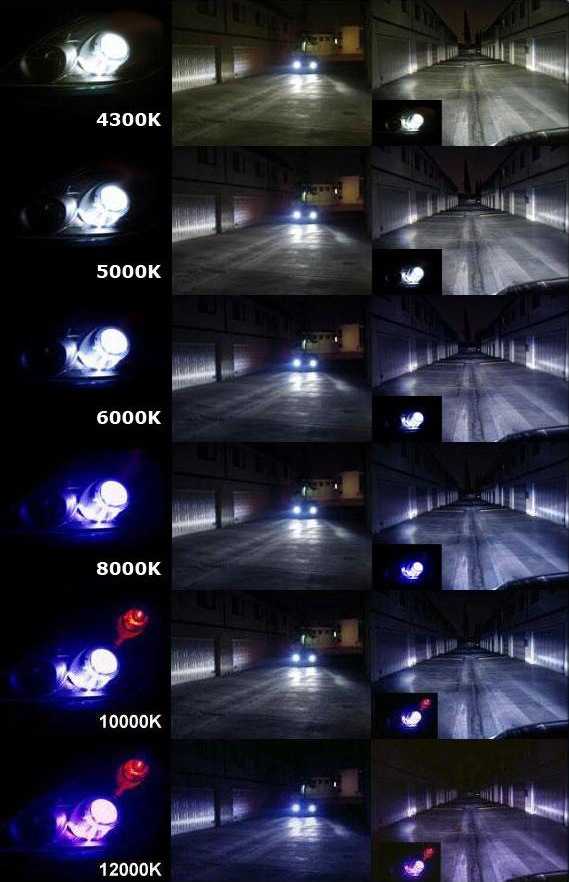Xenon headlights, also known as high-intensity discharge lamps (HID), emit a blue-white light, about two to three times brighter than halogen, last about 2,500 hours, and are energy efficient.
Xenon Headlamp socket on P11
Headlamp (Low Low) : 12V – 55W (H1)
Headlamp (High High) : 12V – 55W (H1)
Xenon Headlamp Dimension for P12
Headlamp (Low Low) : 12V – 55W (H7)
Headlamp (High High distance) : 12V – 55W (H7)
Front fog lamp (PTF) : 12V – 55W (H11)
Xenon Headlamp Dimension for P12 right-hand drive
Headlamp (Low Low) : 12V – 55W (HB4)
Headlamp (High High) : 12V – 55W (HB3)
About Xenon Lamps – Luminous Temperatures
So what is the right light temperature for a Xenon lamp?
The color temperature is measured in degrees Kelvin and reflects the color created by the light source.
Unfortunately, there is a widespread misconception that the higher the color temperature, the more powerful the lamp. The color temperature is just a model that tells us what the temperature of a heated ideal body should be to make it glow in one color or another. So the sun gives us white (as we understand it) light, the temperature on the surface of the sun is 5500K, so we can say that a lamp giving the same light spectrum as the sun has a color temperature of 5500K.
The most common color temperatures of lamps are:
3500K (Yellow) – suitable for fog lights as the main lighting is not suitable
4300K (white-yellow) – the brightest light, this temperature is put on the factory cars in the original
5000K (White) – the white color of xenon light – the most suitable choice! (exactly in terms of beauty / maximum illumination)
6000K (white-blue) cool white with light blue
7000K blue, the brightness is much lower it is hard to drive with this light
8000K (deep blue) light blue-violet, the brightness is even worse
That is, the higher the color temperature, the closer the color of the lamp to purple, and the lower to yellow.
In the illustration below you can roughly estimate how the road surface will look like when using lamps with color temperature HID (8000K), HID (6000K), HID (5000K), HID (4300K), and Halogen (ordinary halogen bulb).

Maximum brightness is reached only at 4300K and as the temperature increases or decreases, brightness drops.
However, many people don’t like 4300K because of the color – it’s bright white-yellow xenon.
That’s why most people prefer 5000K temperature to bright cool white light. The brightness is slightly lower but it is beautiful.
Temperatures above 6000K at the brightest xenon are little suitable for practical use as blue (7000K) and blue (8000K) in brightness is not much better than conventional halogen bulbs.
Do I need it?
Up to 40% of car accidents happen because of poor visibility on the roads. When the weather is bad, the number of accidents increases significantly.
Rain, fog, smog – these are all-natural phenomena that are a frequent companion of drivers. Light from a halogen lamp in rain or fog generates the phenomenon of the so-called light wall. When instead of the roadway you see raindrops or glowing columns of fog.
Xenon is a highly coherent (all spectra are in a narrow range) light source. The higher the coherence of the light, the less it is affected by the environment. Xenon does not form a wall of light.
Here’s a comparison of what HID and halogen lighting looks like
Buying Xenon – what to get?
As a continuation of the theme of Xenon – I went through it myself 8)
And so this text is my IMHO – based on my research and my ultimate decision
There are a lot of manufacturers today – but you can try to identify the most common and without obvious scams
Generally speaking different manufacturers and prices differ only in a few parameters
1) Service life of the unit and lamp
2) The period during which the lamp does not lose its color
All the rest for the most part only differ in price
Here is a sampling of the manufacturer – the price and failure rate
Berus (Korea) – xenon ~ 5000r – bi-xenon ~ 7000r – failures <1%
HELLA 3 (Germany) – xenon ~ 7500r – bixenon ~ 9500r – 2-3% failures
HELLA 4.1 (Germany) – xenon ~ 7500r – bixenon ~ 9500r – refusals <2%
IPF (Japan) – xenon ~ 15900r – bixenon ~ 22900r – refusals <1%
IL Trade (Korea) – xenon ~ 1900p – bixenon ~ 3300p – refusals <1%
MTF-Light (Korea) – xenon ~ 5000r – bixenon ~ 8500r – refusals <1%
Sho-me (Korea) – xenon ~ 3200r – bixenon ~ 6000r – failures <5%
Ignition units
Hella
These are very reliable units. Operate at voltages from nine to fourteen volts.
Berus
Together with Acumen, Berus makes blocks with a rather big working range: from eight to thirty-two volt. However, Berus units have a significant disadvantage. These units use rather rare connectors. Only Berus bulbs can be supplied with these connectors, If it is problematic for you to find such bulbs, then don’t worry. Almost any service center will change the connectors for more common ones. But in this case you lose the warranty on this unit and in case of failure, you will not be able to exchange or repair it under warranty.
Sho-me
No special qualities have not been revealed. But these units are quite popular, as they were the first to fill the market with cheap ignition units. But cheap doesn’t mean bad.
IL Trade
Is distinguished by the best price-quality ratio. Xenon sales experience – 4 years. Failures <0,5-1%. Increased stability of the flight characteristics of the lamps. The solution to the problem of “cheating”.


